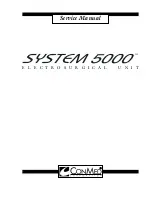
3-2
provides further damping to dissipate the energy more quickly to minimize RF leakage effects. Spray Coag
provides the maximum open circuit voltage for which the system is rated.
3.1.3 Bipolar Major Modes
Major
mode
Minor
Mode
RF fre-
quency
Modulation: Number of
Pulses, Time on/off
Modulation: Frequency &
period
BIPOLAR
MACRO
391 KHz
None
None
MICRO
391 KHz
None
None
3.1.4 Advanced Specialty Modes
Specialty Mode
Effect
General
Normal open surgery mode – Parameters noted above.
Fluids
Temporarily increases power upon activation for faster initiation. Duration and power increase
vary with mode and power setting
Lap
Limits maximum peak voltage for safer laparoscopic surgery. This action does affect the load
curves when in high impedance tissue, or using normally high voltage modes.
3.2
System Overview
Mains power is converted to electrosurgical output
power through the High Voltage Power Supply
(HVPS), the RF Amplifier, and the Transformer
and Output sections of the system.
Mains power is converted to high voltage direct
current power in the HVPS to supply the RF
Amplifier. This universal input power factor cor-
rected, single output, switch mode power supply
is adjustable under software control with 10-bit
resolution. The HVPS output and power factor
correction sections of the HVPS can be enabled
or disabled under software control. The HVPS
uses a current mode two-switch forward converter
topology with short circuit protection and over
voltage limiting.
Pulses generated in the RF Controller are ampli-
fied to electrosurgical power and voltage levels in
the RF Amplifier and Transformer portions of the
power train. The RF Amplifier and Transformer
form a resonant switched mode amplifier with
multiple outputs that are selected on a mode-by-
mode basis using relays on the primary and sec-
ondary side of the transformers. One transformer
is used for monopolar outputs, while the other
transformer is for the bipolar output.
Electrosurgical power flows from the RF
Amplifier and Transformer sections to the Output
section where the power is switched to the specific
electrosurgical outputs. The Output section also
has circuitry to detect activations from accessories
and the circuitry to perform the Automatic Return
Monitor (A.R.M.™) function to ensure the integ-
rity of the dispersive electrode connection.
The power section also includes a number of out-
put voltage and current sensors that are used by
the RF Controller for control of power delivery
and by the Monitor to detect errant output condi-
tions.
The RF Controller is a Digital Signal Processor
(DSP) that generates an RF Amplifier drive sig-
nal based upon measured parameters compared
with settings-based parameters. The pulse train
sequence is a settings-based parameter that is
dependent on the selected mode. Target power,
current limit, voltage limit, and impedance thresh-
olds are all settings-based parameters derived
from a load curve that is specific to the front
panel power setting. The RF Controller samples
electrosurgical output voltage and output cur-
rent from sensors over 450,000 times per second
and uses these sampled values to calculate output
power and sensed impedance. The output power,
output current, output voltage, and sensed imped-
ance are compared with corresponding settings-
based parameters of target power, current limit,
voltage limit, and impedance threshold; respec-
tively; and the RF Controller adjusts the width of
individual pulses within each mode-based pulse
train sequence in a closed-loop fashion to control
corresponding output power. The RF Controller
also adjusts the HVPS output more slowly, allow-
ing adjustment of the RF Amplifier drive pulses





















